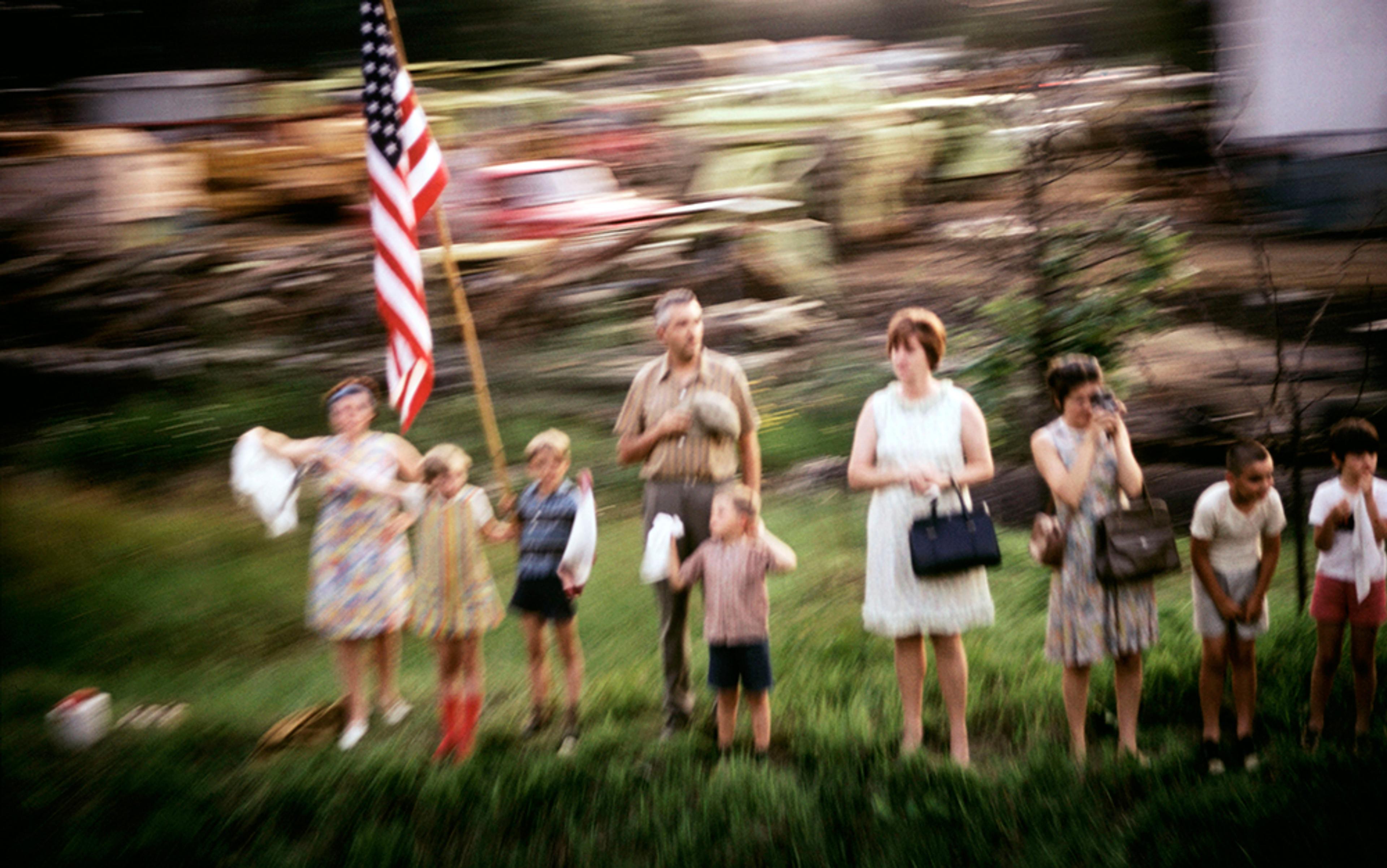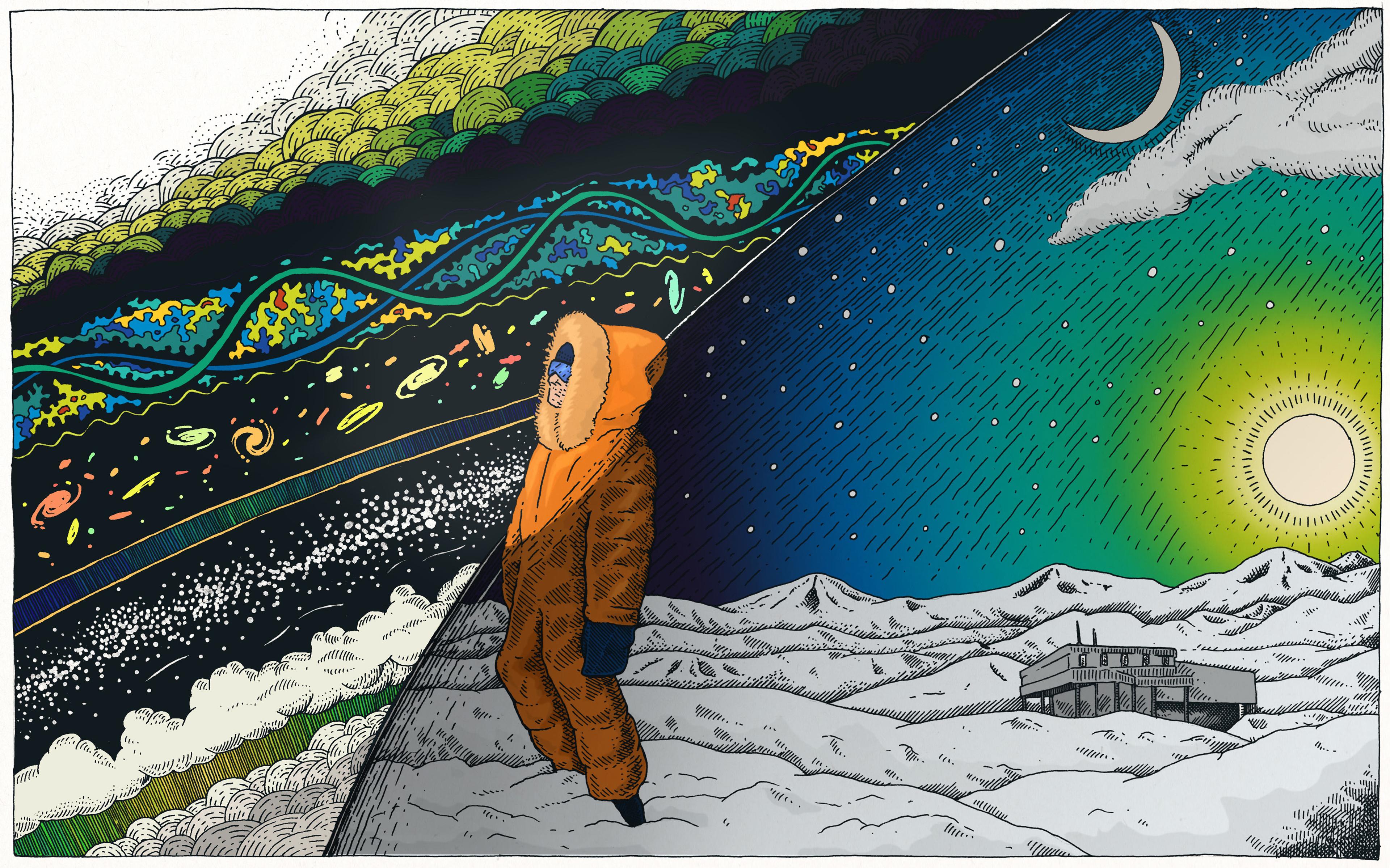Imprisoned in the fortress of Taureau, a tiny thumb of rock off the windswept coast of Brittany, the French revolutionary Louis-Auguste Blanqui gazed toward the stars. He had been locked up for his role in the socialist movement that would lead to the Paris Commune of 1871. As Blanqui looked up at the night sky, he found comfort in the possibility of other worlds. While life on Earth is fleeting, he wrote in Eternity by the Stars (1872), we might take solace in the notion that myriad replicas of our planet are brimming with similar creatures – that all events, he said, ‘that have taken place or that are yet to take place on our globe, before it dies, take place in exactly the same way on its billions of duplicates’. Might certain souls be imprisoned on these faraway worlds, too? Perhaps. But Blanqui held out hope that, through chance mutations, those who are unjustly jailed down here on Earth might there walk free.
Blanqui’s vision of replica worlds might seem fanciful – wishful thinking born of a prolonged confinement, perhaps. Yet it reflects an age-old conundrum that continues to baffle physicists and cosmologists to this day. Does the Universe repeat itself in space or time? Or are we barrelling endlessly forward, never to repeat this moment or arrangement of matter, never to retrace our steps?
While Blanqui imagined human history replicating itself in space, the 19th-century German philosopher Friedrich Nietzsche envisioned repetition over time. He called this ‘eternal recurrence’, also known as ‘eternal return’. Nietzsche, who oscillated between grandiosity and deep depression, prided himself on the ‘discovery’ that he, and everyone else in the world, would relive their lives, again and again, in perpetuity. This was not necessarily a cause for celebration. ‘What if some day or night a demon were to steal after you into your loneliest loneliness,’ he wrote in The Gay Science (1882), ‘and say to you: “This life as you now live it and have lived it, you will have to live once again and innumerable times again; and there will be nothing new in it, but every pain and every joy and every thought and sigh … ?”’ Still, immortality – returning to Earth throughout the aeons – was something of a recompense for the horror of having to re-experience melancholy, sickness and despair.
Both Blanqui and Nietzsche were motivated, at least in part, by Isaac Newton’s laws of motion and the principle of the conservation of mechanical energy. These principles show how the gravitational forces that govern the acceleration of objects also steer the planets into orbit around the Sun. In 1814, the French scientist Pierre-Simon Laplace demonstrated that Newtonian physics, applied to a closed system, allows you to predict to near-perfection what will happen next. ‘We may regard the present state of the Universe as the effect of its past and the cause of its future,’ Laplace wrote in A Philosophical Essay on Probabilities (1814). If you could have perfect knowledge of the positions, velocities and forces that apply to ‘the greatest bodies of the Universe and those of the tiniest atom’, Laplace said, ‘for such an intellect nothing would be uncertain, and the future just like the past would be present before its eyes.’
This determinism, however, ends up eating its own tail. In Newtonian physics, space is a static theatre within which objects move and shift. But suppose those objects are themselves composed of a finite quantity and variety of constituents – any chunk of ice, for example, is made up of hydrogen and oxygen atoms. Given enough time, the possible combinations of constituents would be bound to repeat themselves, both in time and space.
The situation is a bit like an endless tournament of noughts and crosses. Because there is a finite playing field (an array of nine squares) and a finite number of elements (noughts and crosses), eventually any given outcomes must reoccur. Any region of space, of course, would have vastly more components than a game of noughts and crosses, but the principle still holds: the time cycles or spatial repetitions might be inordinately spread out, but chance recombinations would make them inevitable nonetheless.
Conservation of mechanical energy follows directly from Newton’s laws. This precept states that in the absence of friction and air resistance, energy freely converts from one type, potential energy (the energy of an object held in position), into another type, kinetic (the energy of motion). It’s a natural form of recycling. So the pendulum driving a grandfather clock would swing back and forth, turning the potential energy at the highest point of the swing into kinetic energy at the lowest point, over and over. (Of course, in practice, air resistance would gradually slow down that process, unless it were externally restarted.) The relatively steady motion of the Moon in its orbit around Earth testifies to the regularity and repetition engendered by conservation laws.
In this way, science and a sort of mysticism can join hands. Both Blanqui and Nietzsche were materialists, in that they believed human thoughts and feelings were byproducts of chemical mechanisms. All things are fundamentally made of atoms, including whatever mechanisms create the illusion of souls. Consequently, they believed that physical cycles would inevitably lead to a recurrence of ideas and emotions.
Materialism is closely linked to atomism, the notion that everything is composed of a finite array of unbreakable components. The first known atomists were the Ancient Greeks Leucippus and his disciple Democritus, each of whom lived in the 5th century BCE. While some ancient philosophers embraced atomism, there was a much stronger consensus around the idea that time runs in cycles. Unlike Nietzsche’s eternal recurrence, however, the classical view of cycles was much less precise. In most versions, human lives would not recur exactly. Rather, history in general – both human and cosmic – would pass through endless cycles of creation and destruction, like a great wheel of destiny. Many of the ancients believed that Earthly civilisations would ascend from the ashes of previous societies, ascend to golden eras of great power and fortune, turn toward decadence, and plummet into disaster, only to be replaced by other cultures on the rise.
Consider, for instance, the view of Empedocles, a prominent philosopher in the 5th century BCE. He argued that, along with the four classical elements, the world was a mixture of two fundamental forces: Love and Strife. While Love is the attractive force that brings the elements into harmony, Strife serves to divide them. History, Empedocles said, cycles between eras in which Love dominates, eras in which Strife rules, and intermediate intervals in which Love and Strife are mixed in equal quantities.
In later centuries, plotting cycles played a pivotal role in observational astronomy, one of the few exact sciences in the ancient world. Astronomers impressed their sovereigns with an uncanny ability to anticipate the positions of the planets and stars on their paths through the heavens. They were able to anticipate celestial events such as eclipses and conjunctions (when two or more planets are aligned). Given such predictive abilities, the rulers deemed them sages, and turned to them for personal advice – the best time to wage battle, when to hold weddings – as well as astral forecasts. In this way, the pseudoscience of astrology was born, combining celestial knowledge with human advice.
The seasons, the growth cycles of plants, the migration of animals all made ancient peoples see cycles as essential
Plato was a firm believer in the notion of inexact cycles of history, which he thought were closely connected with astral events such as the conjunctions of planets. Believing that circles were perfect emblems of the divine, he argued that every process would eventually return to its starting point. History would cycle through golden ages and epochs of colossal destruction. The ultimate cycle, he contended, was the Great Year: the time between complete alignments in the sky of the five then-known planets, from Mercury to Saturn (although this does not include the Sun and Moon).
Many other cultures of the ancient world believed in cyclical time schemes, although not always in strict repetition: the Babylonians, the ancient Chinese, Mayans, early Hindus and many native American societies. As hunter-gatherer or agricultural communities, of necessity they paid close attention to nature’s ways: the seasons, the growth cycles of plants, the regular migration and hibernation of animals. Partly for this reason, these peoples saw cycles as an essential part of history. Death, therefore, became a portal to reincarnation or some other form of renewed life. Ultimately, nothing was ever truly destroyed; new life would always arise from the loam of decay.
Not everyone agreed. The ancient Hebrews embraced a more sequential view of time. Their scripture taught that the world began at a unique moment, the point of biblical genesis. Human society similarly started at a specific moment, namely the creation of Adam and Eve. The story of the Fall, with the creeping inevitability of illness and death, epitomised the reality of time’s arrow. The changing relationship between humanity and the divine was marked by the revelation of new laws, such as the Ten Commandments. These events suggested that history was a steady stream, flowing from the Fall until the End of Days. Both Christians and Muslims incorporated these notions of divine revelation into their faiths, which led to similar chronologies following a sequence of original sin and redemption. The theological worldview of the Abrahamic religions thus posited a forward march of time, with no possibility of repetition.
Until the early 19th century, physics mandated no particular direction for time. Newton’s laws, for example, run exactly the same forward and backward – which meant, in principle, that machines should be able to run forever. At the height of the Industrial Revolution, manufacturers hoped to achieve this perfect efficiency by constructing flawless engines, which would not lose energy via friction and heat. Surely some clever-enough inventor could eliminate waste? Meanwhile, the rise of railways and factories demanded more accurate timekeeping, standardised machinery, and an accelerated pace of life. It was almost as if history was necessarily advancing toward progress and precision, onward and upward – never back.
In the quest for perfect efficiency, however, waste remained a persistent bugbear. The French physicist Sadi Carnot addressed the problem of the perpetual motion machine in his influential book Reflections on the Motive Power of Fire (1824). He considered the workings of a steam engine: a device that used the expansion and compression of water, as it is respectively heated and allowed to cool, to drive a piston up and down. Rods attached to the moving piston were typically connected to cranks or wheels (such as the driving wheels of a locomotive), setting those, in turn, into motion. This allowed the engine to do work, which is a measure of the ability of a force to move something from one point to another.
Steam engines draw water from a cold basin, heat it up in a boiler, and expel the hot water and steam into a hot basin, where it would be allowed to cool. The larger the temperature difference between the basins, Carnot found, the greater the amount of work performed by the engine. Still, there would always be a significant quantity of waste energy involved. In other words, no matter how savvy the designer, he or she could never develop a perfectly efficient machine: there would always be unusable energy, which would increase over time.
You would never see an ice cube emerge from lukewarm tea, ceding its energy to the liquid
In the 1850s and ’60s, the German physicist Rudolf Clausius generalised Carnot’s results about waste energy into a principle known as the second law of thermodynamics, also called the law of nondecreasing entropy. Entropy measures how much of the energy of any system is unavailable to do work. For example, heat dissipating into the atmosphere from the exhaust of a car cannot be collected and used to power a motorbike. Over time, the second law broadly states, the amount of entropy must naturally increase or, at best, stay the same; it can never decrease. Entropy has an inverse relationship with temperature differences. Heat flows naturally from a hot reservoir into a cold reservoir, potentially doing work in the process (such as driving a turbine). Hence stark temperature differences match efficient, low-entropy situations.
On the other hand, if there was no temperature difference between components of a system – a situation known as thermal equilibrium – no work could be performed. Therefore, entropy would be very high. For instance, while the ocean has an abundance of energy due to the motions of the molecules within it, that energy can be converted into work only if heat can flow from the ocean into something colder. At the time, that wasn’t a realistic solution, and therefore most of the ocean’s energy had little chance of being extracted.
The second law of thermodynamics means that natural processes tend to get less and less efficient over time, because any process that exchanges heat between hot and cold reservoirs tends to equalise their temperatures. That is, their entropy tends to rise. Eventually, when the temperatures even out, the state of thermal equilibrium is reached, and no further work can be done.
Another way of stating the second law, then, is that closed systems naturally tend toward thermal equilibrium. This behaviour defines a distinct arrow of time. If you place an ice cube in a mug of hot tea, you would observe the temperatures balancing out, leading to a lukewarm drink. But you would never see an ice cube spontaneously emerge from lukewarm tea, ceding energy to the liquid and making it steaming hot. If you saw a film of such a strange occurrence, you’d rightly conclude that it was being played in reverse. In this way, the second law dictates that time has a distinct direction: it is linear, rather than cyclical.
Clausius’s conclusions addressed closed systems, such as an engine. But what about the Universe itself? In 1852 the British physicist Lord Kelvin suggested that the Universe as a whole would eventually reach a state of uniform temperature, once all the stars within it had burned out. Once this ‘heat death’ had been reached, no further work could be done anywhere in space.
Back then, no one knew about the processes of nuclear fusion that powered the stars, so estimates of stellar lifetimes were much lower – and the imminent prospect of heat death very frightening indeed. Today, we know that stars can shine for billions of years. Even after their demise, stars leave behind relics, such as white dwarves, neutron stars and black holes, which radiate at various rates (black holes, admittedly, extremely slowly). Nevertheless, eventually – in a time frame far longer than Lord Kelvin envisioned – the Universe, if it keeps going the way it has been, would reach a quiescent state. Time’s arrow of non-decreasing entropy, in other words, seems to be universal.
With the benefit of contemporary instruments and methods, modern science is now striving fervently to try to unravel the nature of time. It has identified new ways of understanding the arrow of time that supplement the law of non-decreasing entropy. The American astronomer Edwin Hubble and others in the 1920s showed that the Universe is expanding. This fact suggests that cosmological time is marching forward, in step with cosmic growth.
Findings by several teams of astronomers in the 1990s demonstrated that cosmic growth is speeding up, apparently due to an unobserved entity known as dark energy. In some theories, dark energy is conceived as strengthening over time. Eventually, it would become so powerful that it should overwhelm all of the other forces of nature and tear apart the fabric of the Universe, well before heat death, in a condition called the Big Rip.
The majority of scientists think that cosmic expansion is irreversible – although a minority, such as Paul Steinhardt of Princeton in New Jersey, Neil Turok of the Perimeter Institute in Ontario, and Roger Penrose of the University of Oxford, have envisioned ways in which the Universe might be renewed in fresh cycles of time. Each of their models is extremely hypothetical. Steinhardt and Turok’s approach, called the ‘cyclic universe’, pictures a periodic collision along a higher dimension (posited in certain theoretical models) of our three-dimensional space with another such space – like two slices of bread smacked together to form a sandwich. Each higher-dimensional collision supplies an energy blast that wipes out evidence of the previous cycle. Penrose’s vision, called ‘conformal cyclic cosmology’ involves a special mathematical transformation called a conformal mapping that twists the beginning and end of the Universe together like a Mobius strip.
Observations and analysis of cosmic microwave background (CMB) radiation have proved vital as a way of understanding cosmology. The CMB is relic radiation that was released some 380,000 years after the Big Bang, and varies slightly in temperature from point to point throughout the sky map. By applying powerful statistical methods to the temperature distribution of the CMB, depicted in colours and sometimes nicknamed ‘the baby picture of the Universe’, such minuscule fluctuations have yielded a treasure trove of data about the nature of space and time.
Nature, even at its deepest level, might have a preference for one direction of time over another
For one thing, the analysed data has helped astrophysicists pin down the age and geometry of the Universe with greater precision. Scientists are now looking at the CMB for telltale clues of earlier cosmic cycles, and scars from primordial collisions between different sectors of the Universe. If such scars were found, they would lend credibility to ‘bubble universe’ models that suggest that the observable Universe emerged from a kind of bubble bath of myriad other expanding parts of space. Each bubble grew up into its own sector of the Universe, including the segment that we see around us. So instead of one Big Bang, there might have been numerous bursts at the same time, spawned from the cosmic froth wherever conditions were right. Scars from such primordial collisions would offer evidence that our region of space is not alone.
When it comes to the subatomic realm of quantum physics, researchers once believed that all processes were completely reversible in time, such as the scattering of electrons from each other, which appears the same if run backward or forward. However, in 1964, the American physicists James Cronin and Val Fitch demonstrated that in rare cases, certain modes of decay of elementary particles, called neutral kaons, violate a condition, called Charge-Parity or CP-invariance, that is equivalent to time symmetry.
Briefly, this means that if you switch all the charges of particles in an interaction (from positive to negative, and vice-versa) and reverse the process spatially, as if it’s reflected in a mirror, the resulting picture would have features similar to the original interaction – except that it would be reversed in time. After such a transformation, a negative electron moving to the right toward a positive proton would appear like a positive positron (the antimatter counterpart of an electron) moving to the left away from a negative antiproton. Reverse the latter process in time, and you’d see the positron and antiproton attract each other, in a perfectly legitimate process. Both the time-forward and time-reversed processes would be equally plausible.
However, try the same steps with Cronin and Fitch’s kaons (in that case, a decay process) and you would see a discrepancy between the likelihood of the time-forward and time-reversed processes. That is, one would be more common than the other. Nature, even at its deepest level, might have a preference for a single temporal direction.
The arrows of time we have observed in nature – due to growing entropy, cosmic expansion and certain physical processes in particle physics – make it extremely unlikely that human events will recur in time. As far as we can see, the Universe is ageing; Nietzsche’s eternal recurrence seems at odds with the world’s fundamental rules. On the other hand, if the Universe is infinite in space, there’s still a chance that planets nearly identical to Earth exist, untold light-years away. If we contemplate an endless cosmos, a spatial repetition of worlds could happen by mere chance. Perhaps on one of them, so far away that we could never hope to observe it, a replica of Blanqui walks free.






